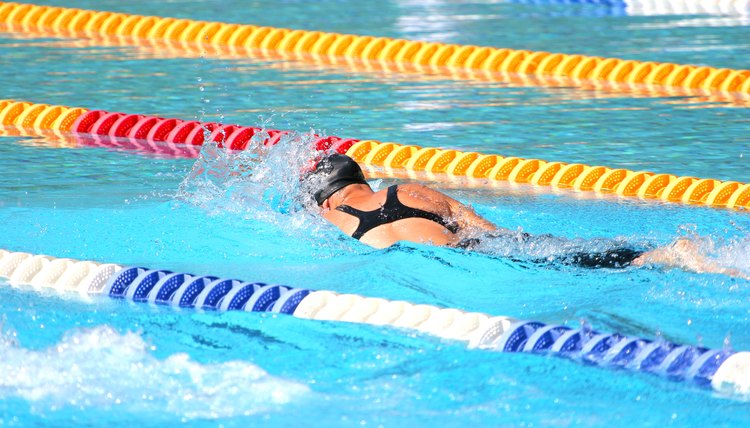Swimming for Soccer

Swimming can help soccer players stay fit in the off-season and serve as a form of cross-training to reduce the risk of overuse injuries. Swim workouts also help to build a soccer player’s cardiovascular endurance. However, the mechanics of a flutter kick for can be a challenge for soccer players.
Endurance to Fend Off Fatigue
Soccer players need to develop aerobic endurance to ward off fatigue. Soccer players can improve endurance by combining cardio sessions with strengthening workouts -- and swimming provides a sound option for cross-training purposes. Overuse and strain of lower-body muscles -- adductor muscles, quads, hamstrings, calves and feet – are the most common injuries in soccer players, according to “Women in Sport” by Barbara L. Drinkwater. A swimming workout can alleviate the stress on your lower-body muscles and joints and help to build your upper-body musculature.
A Strong Heart in the Off Season
During the off-season you can incorporate swimming workouts in your training schedule to maintain cardiovascular fitness. Aim for two to three sessions of 20 to 40 minutes per week of swimming laps, according to Sports Fitness Advisor. For example, on Monday and Friday, combine a 20-minute swimming workout with exercises for your core strength, stability and functional strength. On Wednesday, you can play tennis or badminton for an hour while taking a rest on Tuesday and Thursday. When swimming, monitor your heart rate with the goal of exercising at 60 to 70 percent of your maximum heart rate.
When Soccer Players Plunk into Water
When it comes to swimming, the primary challenge for soccer players -- or any running athlete -- is the kick. An efficient flutter kick for the freestyle or back stroke requires flexible ankles and the ability to point your feet in the water -- something that running athletes struggle with. In addition, the kick originates from the rotation in your hips and not the bend of your knees. An incorrect kick resembles the pedaling of a bicycle underwater. By using fins with short blades, the added load or water resistance will help to stretch your ankles and achieve a better kick, according to Breaking Muscle. Begin an effective stretch for your ankles by sitting on the floor and crossing your right leg over your left. With your left hand, grasp the sole of your right foot and slowly rotate your foot. Then pull the right toes down, working the extension of your ankle. Repeat the stretch for your left ankle.
Running in Deep Water
Aquatic running is another water-based option for soccer players. Performed in either a pool’s deep end or a hydrotherapy pool, deep water running involves wearing a buoyancy vest and running in water. You have to push your hips forward against the water’s resistance to maintain proper form. Because your feet never touch the pool’s floor, you can lower the stress on your lower-body joints as well as the compressive forces on your spine, according to “The Science of Training – Soccer: A Scientific Approach to Developing Strength, Speed and Endurance” by Thomas Reilly. This aquatic exercise builds aerobic endurance and can speed up the recovery of your muscles and alleviate soreness after competition or rigorous dry-land workouts.
References
- Any Given Monday: Sports Injuries and How to Prevent Them for Athletes…; James R. Andrews
- Complete Conditioning for Soccer; Greg Gatz
- Coaching Girls' Soccer Successfully; Debra LePrath
- BBC: Performance Fitness Requirements for Football
- Breakthrough Swimming; Cecil Colwin
- Breaking Muscle: I'm a Triathlete, I Don't Kick When I Swim
- The Science of Training – Soccer: A Scientific Approach to Developing Strength, Speed and Endurance; Thomas Reilly
- Women in Sport; Barbara L. Drinkwater, Editor
Writer Bio
Kay Tang is a journalist who has been writing since 1990. She previously covered developments in theater for the "Dramatists Guild Quarterly." Tang graduated with a Bachelor of Arts in economics and political science from Yale University and completed a Master of Professional Studies in interactive telecommunications at New York University.
